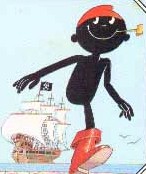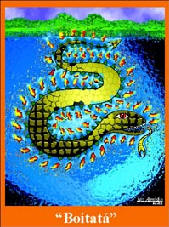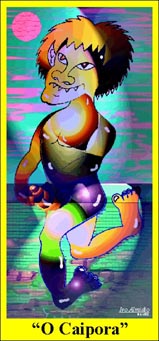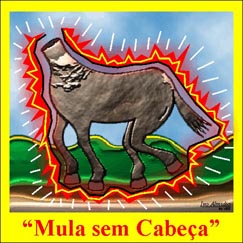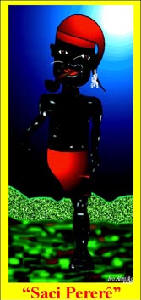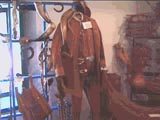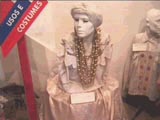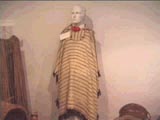|
FOLKS COSTUMES AROUND THE GLOBE |
|
|

Myths & Fantastic Creatures
ANHANGÁ - Amazonian mythological character that protects nature, specially animals. It comes in a deer form with fire eyes covered by fur. BICHO-PAPÃO - a kind of man-animal, that frighten children, because they can appear for eating them if they don't eat rightly or not obey their parents. This mythological is a lot used by parents to frighten their children.
BOITATÁ - Fire-snake that roaming about country-side, protect there from those who fire them.
CHUPA-CABRAS - Brazilian Southeast mythology. An animal that looks like wolf kills domestic animals, mainly chicken, dogs, goats and sheeps, sucking their blood by a hole they do in the neck of the victim. It has been calling the press attention recently. CUCA - Witch that looks alike a big green caterpillar, that is always being bad with her witchcraft. It can be a woman with bad aspect and that takes children that are not sleeping at night. CURUPIRA - This name comes from "tupi": curu- meaning boy and pira- body. With red hair and inverted feet to throwing off the hunters, it protects forests. It is said to be the first Brazilian lend, being told by José de Anchieta when he wrote about Indians fears. JURUPARI - mythological character of Amazonian Indian people, that mysteriously teaches the costumes, social rules and has created sacred instruments. LOBISOMEM - this myth has come from Europe. The character is a wolf that threatens people in nights with full moon. The Werewolf is a man who has been transformed as a punishment, by having infringed some religious and social costumes MÃO GRANDE - Typical mythological character form Pantanal- Brazil. It is a man that walks around this area and that seizes rider by the neck with its big hands and kills him. MAPINGUARI - Amazonian mythological character that laughs loud, frightening people. It just dies if reached by a bullet done of candle wax that have been lightened in a Christmas Night.
MULA-SEM-CABEÇA - It is a non-head mule that throw fire by the nose and mouth in the nights of Thursdays do Fridays. Its neigh is listened in big distances, making people afraid. People say that it is a woman that becomes in the form of this animal because she had an affair with a priest. NEGRO D'ÁGUA - Brazilian Central-West mythology. It is a half man, half fish, with monkey's ears and a fish's comb and that knock down the canoe if the fisher does not give it a piece of fish. It is said that it is so strong and was seen by almost every fisherman in the region. PAIQUERÊ - Brazilian south mythology originated by Indian tradition. Paiquerê is a kind of paradise, with beautiful fields, rivers and trees full of fruits.
Regional Dances
Clothes
pesquisa http://www.aultimaarcadenoe.com/folcloreingles.htm http://www.aultimaarcadenoe.com/folcloreingles.htm http://www.maria-brazil.org/cordel.htm |
/Home/ /folks/ /Bumba-meu-boi/ / Dances / /Myths & Fantastic Creatures / /cordel literature/


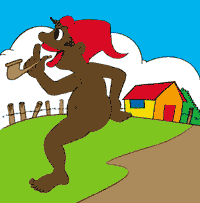
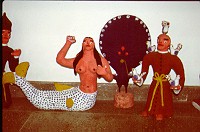 Also known as "mãe
d'água" (mother of the waters). According to Brazilian folklorists,
Iara was not a siren, originally, but a water snake, also called
mboiaçu - mboi, serpent and açu, big - in Tupi. In the 19th
century, a process of convergence occurred, between the Amazonian
water snake and the European myth of the beautiful half-human,
half-fish creature who lures fishermen with her song. The
Brazilian romantic poet Gonçalves Dias created the name, from the
Tupi language of Brazil: ig - water - and iara - lord. The
Afro-Brazilian orixá,
Also known as "mãe
d'água" (mother of the waters). According to Brazilian folklorists,
Iara was not a siren, originally, but a water snake, also called
mboiaçu - mboi, serpent and açu, big - in Tupi. In the 19th
century, a process of convergence occurred, between the Amazonian
water snake and the European myth of the beautiful half-human,
half-fish creature who lures fishermen with her song. The
Brazilian romantic poet Gonçalves Dias created the name, from the
Tupi language of Brazil: ig - water - and iara - lord. The
Afro-Brazilian orixá,
